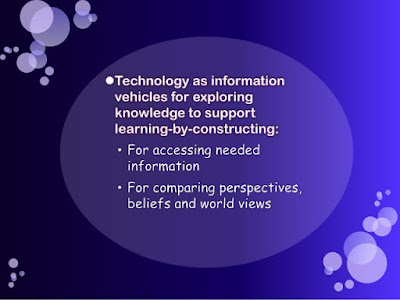TEACHING WITH CONTRIVED
EXPERIENCES
Introduction
If for one reason or
another, we cannot employ direct experiences as
materials for instruction, let us make use of an “edited” version of direct
experience-the contrived experiences.


Discussion Questions:
1.
Did the materials help you visualize
an atom? Understand
better the rotation of the planets on their axis and their revolution around
the sun? With a
clearer picture of the earth?
2.
Do you think the school election
would give the students a feeling of what it means to conduct or participate in
an election process?
3.
Why is the atom depicted by a model?
Is it not better if you see the real atom itself?
4.
Can you think of a better way of
seeing planet earth other than the globe? Why?
5.
Is there more interesting way of
showing the rotation of the planets on their axis and their revolution around
the sun? Why?
6.
What good do students get when they are made to
participate in an election process very similar to what take place in a
democratic country like ours? Wasn’t making the students observe the conduct of
local and national election process enough for them to learn about elections?
Why? Why not?
7.
Biology is a real science of life if
what you study are alive. Justify the use of preserved specimens in Biology.
What is Contrived
Experiences?
1.
These are “edited” copies of reality
and are used as substitutes for real things when it is not practical or not
possible to bring or do the real thing in the classroom.
2.
These contrived experiences are
designed to simulate to real-life situations.
3.
The model of the atom, the globe,
the planetarium, the simulated election process and preserved specimen fall
under contrived experiences, the second band of experiences in Dale’s Cone
of Experience.
Various Forms of Contrived Experiences
1.
MODELS
A model is a
“reproduction of a real thing in a small scale, or large scale, or exact size –
but made of synthetic materials.” (Brown, et al, 1969)
2. MOCK
UP
A mock up is “an arrangement of a real device
or associated devices, displayed in such way that representation of reality is
created.” (Brown, 1969)
3. SPECIMENS
AND OBJECTS
A specimen is any individual or item
considered typical of a group, class or whole.
Objects may also include artifacts
displayed in a museum or objects displayed in exhibits or preserved insects
specimens in science.
4.
SIMULATION
Simulation is a “representation of a manageable real event in which
the learner is an active participant engaged in learning a behavior or in
applying previously acquired skills or knowledge” (Orlich, et al 1994).
5.
GAME
Is there a difference between a game
and a simulation?
Games are played to win while simulation need not a have a
winner.
Simulations seem to be more easily applied to the study of issues
rather than the processes.
WHY DO WE MAKE USE OF CONTRIVED EXPERIENCES?
1.
Overcome limitations of space and
time;
2.
To “edit” reality for us to be able
to focus on parts or a process of a system that we intend to study;
3.
To overcome difficulties of size;
4.
To understand the inaccessible
5.
Help the learners understand
abstractions.
We
use simulations and games to make our classes interactive and to develop the
decision-making skills and knowledge construction skill of our students.
Orlich, et al, (1994)
enumerates ten general purposes of simulations and games in education:
1.
To develop changes in attitudes.
2.
To change specific behaviors.
3.
To prepare participants for assuming
new roles in the future.
4.
To help individuals understand their
current roles.
5.
To increase the students’ ability to
apply principles.
6.
To reduce complex problems or
situations to manageable elements.
7.
To illustrates roles that may affect
one’s life but that one may never assume.
8.
To motivate learners.
9.
To develop analytical processes.
10. To sensitize individuals to another person’s life role.
Games
Games
are used for any of these purposes:
1.
To practice and/or to refine
knowledge/skills already acquired.
2.
To identify gaps or weaknesses in
knowledge or skills, purposes:
3.
To serve as a summation or review,
and
4.
To develop new relationships among
concepts and principles.
GUIDE QUESTIONS IN EVALUATING CONTRIVED EXPERIENCES
Edgar Dale (1969) enumerates the
following:
• Is the model or mock up necessary or can you make use of the
original?
• Could some other devices such as photograph or chart portray
the idea more effectively?
• Is the idea appropriate for representation in a model? (is
it too elementary? Too complicated?)
• Are the important details of details correct?
• Could wrong impressions of size, color, and shape result
from using this model?
• Does the model oversimplify the idea?
• If it is workable, will it stand up under frequent use?
• If it is to be made by students, is the model likely to be
worth the time, effort, and money involved?
• If it is purchased, will the model be used often enough to
justify its cost?
• Will the model act as a stimulus to further learning?
• Does the stimulated procedure reduce the amount of
instruction required to master the desired skills, attitude and information?
“We teach through a re-arrangement of the raw
reality: a specimen, a manageable sample of a whole… when the direct experience
cannot be used properly in its natural setting.”
- Edgar Dale















